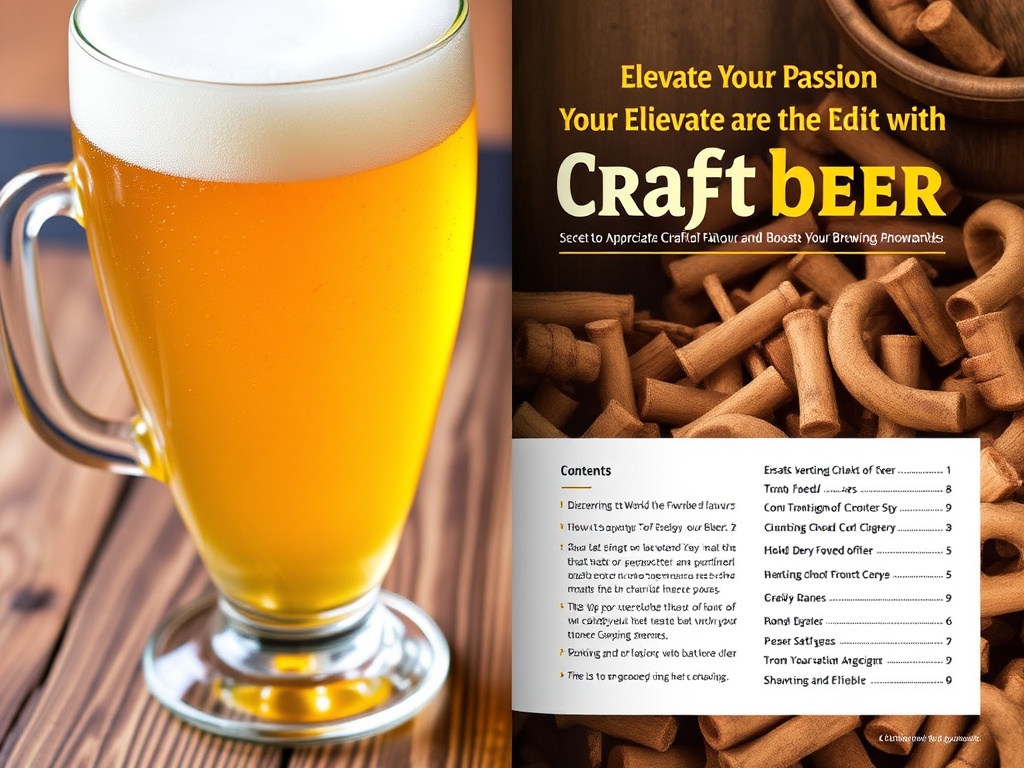Elevate Your Passion with Craftbeer: Secrets to Savoring Exceptional Flavors and Boosting Your Brewing Knowledge

As someone who’s always been passionate about exploring new tastes, I’ve found that craftbeer offers a universe of flavors waiting to be uncovered. In my experience with craftbeer, I’ve learned that truly appreciating this craft requires more than just tasting—it’s about understanding the nuances behind each brew. I want to share what I’ve discovered on elevating my passion for craftbeer and how you can do the same, whether you’re a seasoned enthusiast or just starting out.
From what I’ve learned, diving into the world of craftbeer is both an art and a science. It’s about savoring complex flavors, experimenting with different styles, and expanding your knowledge about brewing processes. I believe that with a little guidance, anyone can develop a deeper appreciation for craftbeer. So, let’s get started on my journey of discovering extraordinary flavors and enhancing our brewing expertise!
Discovering the World of craftbeer
Understanding What Makes craftbeer Unique
In my experience, the first step to elevating my passion for craftbeer was understanding what sets it apart from mass-produced beers. Craftbeer emphasizes quality, creativity, and traditional brewing methods. I’ve discovered that each craftbeer tells a story through its ingredients, brewing techniques, and regional influences. From hoppy IPAs to rich stouts, the diversity is incredible.
From my research, I’ve found that supporting independent breweries not only offers unique flavors but also preserves brewing traditions. I recommend trying beers from local craft breweries to experience the authentic essence of craftbeer. You’ll likely find flavors and styles that you won’t get from mainstream brands, which significantly enhances your tasting experience.
The Evolution of craftbeer: A Personal Journey
My journey with craftbeer started a few years ago when I attended a local beer festival. I was blown away by the variety and craftmanship involved. Since then, I’ve been exploring different brewing styles, ingredients, and even homebrewing myself. It’s a rewarding hobby that constantly teaches me new things about flavor profiles and brewing techniques.
I believe that every new brew I try adds to my understanding of craftbeer. It’s not just about drinking; it’s about appreciating the effort that goes into each batch. I recommend keeping a tasting journal to track your favorites and learn what flavors resonate most with you.
How to Appreciate the Flavors of craftbeer
Developing Your Palate for craftbeer
In my experience, developing a refined palate for craftbeer takes time and deliberate tasting. I recommend starting with a variety of styles—pilsners, IPAs, porters—and paying attention to the aroma, appearance, taste, and mouthfeel. I’ve found that smelling the beer before sipping reveals a lot about its ingredients and brewing process.
From what I’ve learned, taking notes on each tasting helps identify what flavors you enjoy most. I suggest trying beers at different temperatures, as temperature can influence flavor perception. Over time, you’ll notice patterns and develop a more sophisticated appreciation for craftbeer.
Pairing craftbeer with Food
One of my favorite ways to savor craftbeer is pairing it with food. I’ve discovered that certain styles complement specific dishes beautifully—like a hoppy IPA with spicy foods or a rich stout with chocolate desserts. I recommend experimenting with pairings to enhance both the beer and the meal.
From my perspective, food pairing elevates the entire experience, allowing you to taste new dimensions in both the craftbeer and the dish. It’s a fun and educational way to deepen your understanding of flavor profiles and brewing styles.
Mastering Your Own craftbeer Brewing Skills
Getting Started with Homebrewing
In my experience, brewing craftbeer at home is one of the most rewarding ways to deepen your passion. I recommend starting with a beginner’s kit—it’s simple, affordable, and provides all the essential ingredients and instructions. From my first batch, I learned how vital precise measurements and sanitation are to achieving a great brew.
I’ve discovered that patience is key in homebrewing. Monitoring fermentation temperatures and giving the beer enough time to mature makes a huge difference. I believe that experimenting with different ingredients and styles helps you understand the complexities of craftbeer brewing.
Tips for Improving Your Craftbeer Recipes
My research shows that keeping detailed notes on each batch helps refine your recipes. I recommend tracking ingredients, fermentation times, and tasting notes to identify what works best. Over time, I’ve found that small adjustments can significantly improve flavor and aroma profiles.
I believe that joining brewing communities or forums can provide valuable feedback and inspiration. Sharing your craftbeer creations and learning from others accelerates your growth as a homebrewer.
Exploring the Best craftbeer Brands and Styles
Top craftbeer Brands I Recommend
In my experience, some brands consistently deliver exceptional craftbeer. I recommend trying beers from well-known breweries like Sierra Nevada, Bell’s Brewery, and local favorites in your area. Each offers unique styles that can expand your palate and understanding of craft brewing.
From what I’ve learned, supporting smaller breweries and new entrants is equally rewarding—they often push the boundaries of flavor and innovation. I encourage you to explore different brands and styles to find your personal favorites and elevate your craftbeer journey.
Popular Styles of craftbeer and How to Enjoy Them
My favorites include hoppy IPAs, malty porters, sour ales, and complex stouts. Each style has distinct characteristics that appeal to different tastes. I suggest trying a flight of various styles at a brewery or craft beer bar to compare and contrast.
In my experience, understanding the nuances of each style helps you appreciate the craftsmanship behind craftbeer. I recommend keeping a tasting journal to remember what styles and flavors resonate most with you.
References and Resources
Throughout my research on craftbeer, I’ve found these resources incredibly valuable. I recommend checking them out for additional insights:
Authoritative Sources on craftbeer
-
Brewers Association
BrewersAssociation.orgThis industry leader provides comprehensive resources on craftbeer trends, brewing techniques, and industry insights, making it essential for enthusiasts and professionals alike.
-
BeerAdvocate
BeerAdvocate.comA vibrant community and review site that helps me discover new craftbeer styles and breweries, based on honest user feedback.
-
CraftBeer.com
CraftBeer.comOfficial site of the Brewers Association, offering articles, brewing tips, and educational content that deepens my understanding of craftbeer history and innovation.
-
Science of Beer
ScienceOfBeer.comProvides scientific insights into brewing processes, ingredients, and flavor chemistry—perfect for those of us who want a deeper technical understanding of craftbeer.
-
RateBeer
RateBeer.comA community-driven platform for reviewing and rating craftbeer. It’s been instrumental in helping me discover hidden gems and new styles.
-
The British Guild of Beer Writers
CraftBrewing.org.ukOffers articles, interviews, and insights into innovative brewing practices and trends in the craftbeer industry worldwide.
-
Journal of the American Chemical Society
ACS.orgFor those interested in the scientific aspects of brewing, this journal offers peer-reviewed research on brewing chemistry, flavor development, and fermentation science related to craftbeer.
Frequently Asked Questions
How can I start learning about craftbeer flavors?
In my experience, the best way to start is by tasting a variety of craftbeer styles and paying close attention to aroma, appearance, and flavor. I recommend keeping a tasting journal to note what you like and dislike, which gradually sharpens your palate and understanding of different brews.
What are some essential tools for homebrewing craftbeer?
I believe that a basic homebrewing kit, including fermenters, bottles, a thermometer, and sanitizing supplies, is crucial. From my experience, cleanliness and accurate temperature control are key to brewing successful craftbeer. Over time, I’ve added a few specialized tools to refine my process.
How does craftbeer differ from commercial beers?
In my experience, craftbeer tends to focus on quality, flavor complexity, and innovation, often using traditional ingredients and methods. Commercial beers are usually produced on a larger scale with an emphasis on consistency and shelf stability. I find that exploring craftbeer provides a richer and more diverse tasting experience.
What are some emerging trends in craftbeer?
From my research, I see a growing interest in sour beers, low-alcohol options, and innovative ingredients like exotic fruits and spices. Many breweries are also focusing on sustainability and eco-friendly practices, which I believe is shaping the future of craftbeer.
Conclusion
In conclusion, my research on craftbeer has shown me that this vibrant beverage offers endless opportunities for exploration, appreciation, and even brewing. I hope this guide helps you deepen your understanding of flavors and inspires you to elevate your craftbeer experience. Whether you’re tasting, pairing, or brewing, I believe that embracing the craft will enrich your passion and enjoyment of this incredible world of beer.
Find out more information about “craftbeer”
Search for more resources and information:




